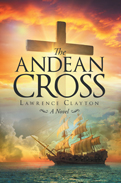
 |
Treasures and secrets buried in the deep living seas sets in motion Clayton’s high-stakes, conspiracy thriller. When Dr. Matthew Western happens upon a riddle involving precious cargo from a centuries-old ship, he seeks help from a Professor Valdez (“the Friar”) at the Archives of the Indies in Seville, Spain. What intrigues Matthew and Professor Valdez is a thorough report of the wrecked ship called the Nuestra Señora de los Milagros, lost at sea in 1544. There are connections directly to Spain and King Charles I, and what Matthew is most curious about is a section of the report written in code, further shrouding the ship’s contents in secrecy.
Matthew embarks on a globetrotting journey that ultimately takes him to the bottom of the “dark Caribbean Sea.” Joining him along the way is deep-sea diver Anthony Lamb, professional geographer Peter Borden, friend Pedro Artigas, and a beautiful anthropologist named Dr. Clarissa (Clair) Snowden. Their hopeful expedition yields a significant find in the form of a “small gold, bejeweled icon” with “three gold triangles” that meet, and “at their juncture a large round emerald circumscribed the center.” Unbeknownst to them, this cruciform icon represents a possible historical and religious significance that is both far-reaching and a game-changer for world history.
Of course, their expedition doesn’t come without costs as the group faces complications from the Republic of Panama’s laws, regulations, and changing political landscape. Other dangers and violence come from the cartel and its power-hungry drug trade and modern-day pirates, complicating matters and putting their lives at risk. As they all work quickly to determine the value and meaning of the rare discovery, they must equally ensure their well-being and safety. Matthew’s search finally brings him to the United States and then back to Spain, where high in the Andes a revelatory discovery deep in the “catacombs beneath the monastery” sheds new light.
Clayton’s complex tale of Spanish conquests and modern-day treasure hunters is replete with codes, symbology, and clandestine societies, making the story come across as something akin to Dan Brown’s The Da Vinci Code set upon the high seas. While reading the erudite novel it becomes clear that Clayton, a professor emeritus of history, is familiar and well-versed in matters of South America’s history and modern-day culture, which largely threads his story together. He also infuses wry humor, serious drama, and romance into the dense tale set amid the sticky heat of the tropics. Following the usual tropes of action-adventure novels, Clayton provides readers with plenty of ancient secrets, codes, and hidden treasures along with political intrigue and standard heroes versus villains to build out the plot.
However, the large host of characters that form Clayton’s book does require the reader to keep up with and remember a lot. Main characters interact with seemly irrelevant minor characters that appear again later at critical moments, while some emerge and disappear without much fanfare. Much of the story is laden with intricate political and social commentary, which slows the narrative’s pace somewhat. Some minor errors include a noticeable lack of quotation marks, which makes the character dialogue confusing at particular moments. There’s also the unusual usage of scene breaks and transitions indicated by the bold printed “Scene Shift” and “Change Scene.”
Yet, Clayton’s skillful writing manages to engage the reader and keep the pages turning. His gift for crafting beautiful descriptions shines throughout, more than making up for any surface issues in the book. These descriptions hint at Clayton’s special reverence for history and the mysteries of the sea with such lines as “He lay motionless over the floor of the sea, suspended in time” or “the anchor broke the surface of the water and rose into the air like some antique sea creature, petrified by time and the sea’s crustaceans.” Clayton invokes haunting images of what remains undiscovered and buried across time.
The novel strengthens gradually until it finally becomes riveting, picking up pace toward its end as Matthew’s journey brings him full circle to Spain and to the holy catacombs among “the bodies and bones of hundreds of the faithful.” One can feel the chill of a noteworthy revelation coming. Overall, the novel is entertaining and absorbing and will largely appeal to fans of historical suspense. With an unresolved ending it seems Clayton is primarily laying the groundwork here for future novels in a possible series to feature protagonist Matthew Western and accompanying characters. For now, readers will have to be content to enjoy this alluring first novel.